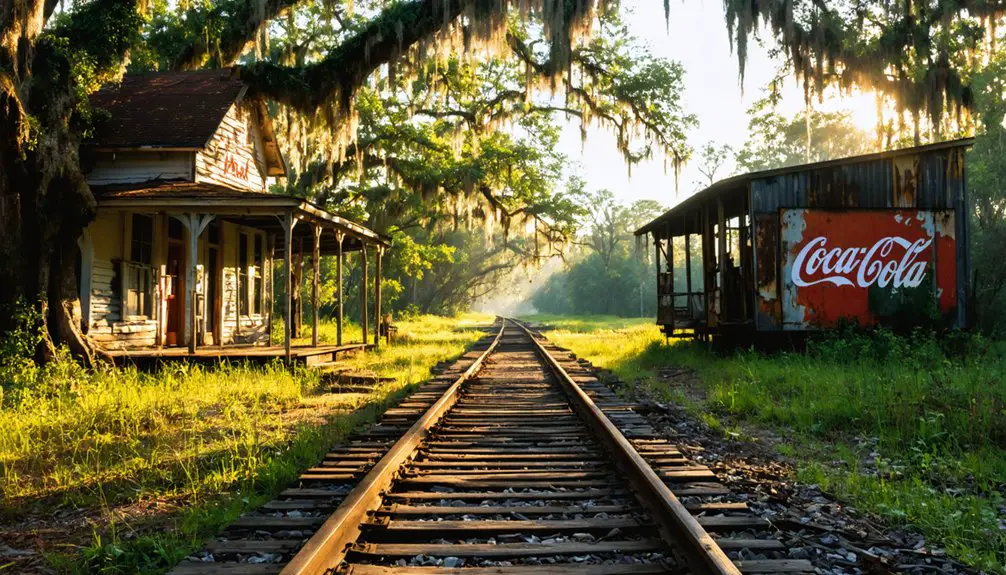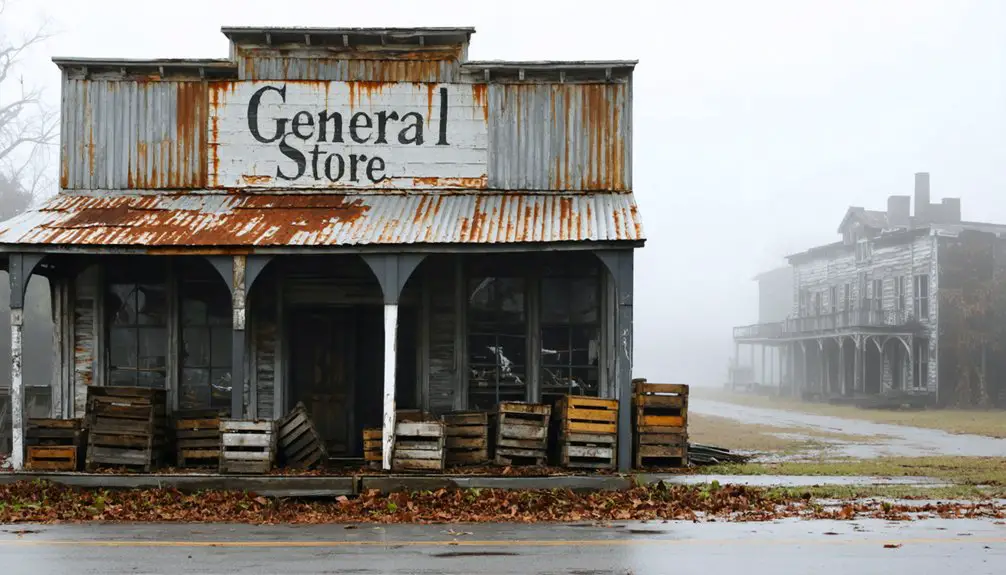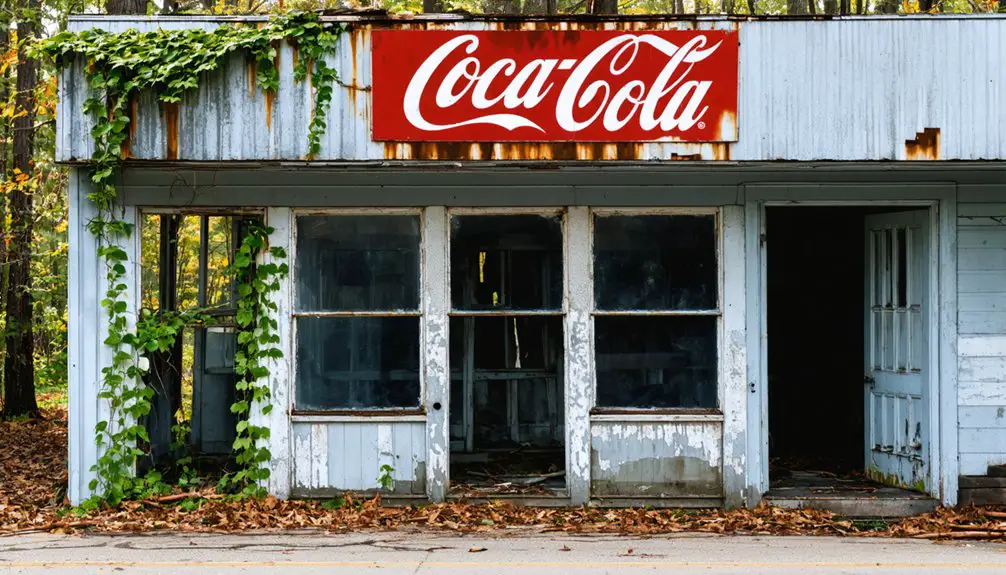You’ll find Rital nestled along Florida’s Withlacoochee River, where pioneer families from Maine and New York established a thriving settlement in the late 1800s. The community flourished through river trade, agriculture, and the arrival of the Atlantic Coast Line Railroad. The devastating freeze of 1894-95 struck a heavy blow, with temperatures plunging to 7°F and destroying essential citrus crops. Today, Rital’s story lives on through its family cemeteries and hidden traces in the Withlacoochee State Forest.
Key Takeaways
- Rital emerged as a late 1800s settlement along the Withlacoochee River, becoming a trade hub for phosphate, lumber, and agricultural goods.
- The devastating freeze of 1894-1895 destroyed citrus crops and triggered population shifts, contributing to Rital’s decline.
- Railroad expansion initially boosted Rital’s growth but later economic changes and agricultural challenges led to its abandonment.
- The Oriole Cemetery, established in 1890, remains as a historical marker of the former settlement within Withlacoochee State Forest.
- Pioneer families from Maine and New York established self-sufficient communities before Rital’s eventual transformation into a ghost town.
Early Settlement and Pioneer Families
While Florida’s post-Civil War expansion drew settlers to various remote locations, Rital emerged as a small but notable settlement in the late 1800s.
You’ll find that pioneer challenges shaped the community’s settlement dynamics, as families from Maine and New York ventured south to establish new lives. These hardy settlers faced isolation and self-sufficiency demands, engaging in orange growing and livestock raising to sustain themselves. Early settlers relied heavily on pork and beef as dietary staples. The establishment of the Oriole Post Office in 1884 marked a significant milestone in the region’s development.
Early settlers from the Northeast adapted to Florida’s frontier, growing citrus and raising livestock while building self-reliant communities.
They’d trade goods among themselves, adapting to life without access to larger markets. The settlement patterns mirrored those of nearby communities like Oriole, where approximately 100 white inhabitants formed tight-knit agricultural communities.
Though some local plantation owners held slaves, the post-war period brought significant changes to the social fabric, leaving family cemeteries as silent witnesses to these early pioneers’ stories.
Life Along the Withlacoochee River
You’d find that Rital’s position along the Withlacoochee River made it a crucial link in the region’s late 19th-century trade networks, connecting timber operations and agricultural enterprises to larger markets.
The river’s navigable waters allowed shallow-draft steamers to transport phosphate, lumber, and farm goods, while supporting the development of riverside agricultural operations that relied on the fertile floodplain soil. Dating back to the 2nd Seminole War, these vessels proved essential for military transport and established lasting navigation routes. The area had historically served as a strategic refuge for Seminole tribes during their conflicts with American forces.
Local farmers and merchants established trading posts and landings along the riverbank, creating a bustling commercial corridor that served both the town’s residents and passing vessels.
River Trade Networks
Since the 1830s, the Withlacoochee River served as an essential artery for military operations, commerce, and agricultural development in central Florida. The river transport system connected crucial military posts like Fort Dabney, enabling troops and supplies to reach strategic positions during the Second Seminole War.
Trade routes later expanded to support booming industries, with shallow-draft steamers carrying timber, phosphate, and agricultural goods throughout the region. The emergence of Cummer Sons Cypress in 1922 further strengthened the river’s role in commerce.
- Man-made canals linked the Tsala Apopka chain of lakes to enhance navigation
- Railroads and tram systems developed alongside the river, creating a robust transportation network
- River towns like Lacoochee flourished through combined water and rail access
- Natural water fluctuations shaped trade patterns, requiring merchants to adapt their shipping strategies
The river’s commercial significance peaked during the late 1800s, transforming settlements into bustling trade centers that supported Florida’s growing industries.
Riverside Agricultural Development
As the Withlacoochee River shaped the surrounding landscape, diverse agricultural enterprises emerged along its banks during the late 1800s.
You’ll find that farmers and ranchers adapted their land management practices to the river’s natural rhythms of flooding and drought, creating a patchwork of productive lands along the corridor.
Farming techniques evolved to match the challenging environment, with ranchers installing berms and ditches to control water flow for grazing lands.
They’d plant bahiagrass for cattle pastures, while preserving remnants of longleaf pine and native woodland species.
The river’s fluctuating water levels, known as “Little Big Water,” influenced how you’d work the land.
This agricultural mosaic still tells the story of adaptation, as wetland communities of bald cypress and buttonbush intermingle with managed pastures and farmland.
The area’s rich timber resources included vast stands of virgin cypress trees that stood for over a century before intensive logging began in the 1920s.
The establishment of Withlacoochee State Forest in 1958 helped preserve much of this historic agricultural landscape for future generations.
Agricultural Ventures and Orange Groves
While the Everglades region remained largely waterlogged in the early 1900s, drainage efforts beginning in 1904 transformed Rital and its surrounding islands into viable agricultural land. Early settlers relied on processing sad plants to produce starch for sustenance while establishing their farms. The establishment of the Lake Worth Drainage District in 1915 helped reclaim thousands of acres for farming.
Through agricultural innovation and citrus cultivation, farmers cleared native vegetation to establish diverse crops, including vegetables and fruit trees. You’d find expansive operations like the 700-acre farm on nearby Torry Island showcasing the region’s agricultural potential.
- Early farms produced peas, beans, peppers, potatoes, tomatoes, and eggplants
- Citrus groves flourished alongside banana, grapefruit, and avocado trees
- The Florida East Coast Railroad’s extension to Miami enabled profitable northern market access
- Experimental agriculture thrived, with farmers testing multiple varieties of fruits like guava, pomegranate, and figs
The combination of native knowledge and immigrant expertise, particularly from Black Bahamians skilled in similar terrain farming, drove agricultural success in this challenging environment.
Trading With Native Seminoles
During the late 19th and early 20th centuries, Rital became a significant trading hub between Seminole tribes and white settlers, with trading posts serving as essential economic bridges between the two communities.
Trading posts in Rital created vital economic connections between Seminoles and settlers, fostering commerce while preserving cultural boundaries.
You’d find Seminole Trade thriving as native hunters brought in valuable animal pelts, alligator hides, and prized bird plumes, especially egret feathers. In exchange, they’d receive manufactured goods like sewing machines, guns, and ammunition.
The Cultural Exchange at Rital’s trading posts was carefully managed, allowing Seminoles to maintain their autonomy while accessing necessary supplies. Like other posts such as Ted Smallwood’s Store, the trading post integrated postal services with regular trading activities.
These posts served as neutral ground where trusted relationships developed between traders and Seminoles, who’d otherwise keep their camps hidden from expanding American settlements.
This arrangement helped preserve Seminole independence while adapting to changing economic pressures.
The Railroad’s Impact on Growth

The arrival of the Atlantic Coast Line Railroad transformed Rital’s economic landscape far beyond its trading post origins. The railroad expansion brought crucial connectivity, linking the area to Tampa and other major markets while spurring dramatic economic transformation through new industries and opportunities.
- Railroad depots and post offices shifted locations based on rail access, directly influencing where communities thrived or declined.
- Phosphate mining and logging operations flourished with newfound ability to transport heavy cargo efficiently.
- General stores and trading posts gained access to broader markets, diversifying their inventory and customer base.
- Iron trestle bridges and strategic rail routes created a transportation network that connected Rital to neighboring towns, fostering regional commerce and population movement.
You’ll find that the railroad’s presence determined not just Rital’s growth, but its very survival in the competitive landscape of early Florida settlements.
Oriole Cemetery: A Historical Legacy
Established through a formal deed signing on October 6, 1890, Oriole Cemetery stands as Hernando County’s third oldest burial ground and a tribute to Florida’s pioneer spirit.
You’ll find this historical treasure nestled in the Withlacoochee State Forest, where cemetery preservation efforts maintain its connection to the area’s past.
Seven original trustees, including members of the Giddens family, managed this one-acre plot, overseeing burials and plot assignments for the Oriole settlement’s residents.
Today, you can explore this piece of local heritage among the natural cypress ecosystem, where weathered markers tell stories of the pioneering families who settled here.
While the town of Oriole has vanished into history, its cemetery remains a tangible link to the community’s legacy and early Florida settlement patterns.
The Great Freeze and Economic Decline

Striking Florida with devastating force, the winter of 1894-1895 brought two catastrophic freezes that forever changed Rital’s destiny.
You’ll find that temperatures plummeted to an unprecedented 7°F near Polk County, destroying citrus crops and killing trees across the region. This devastating event shattered Rital’s heritage and tested the economic resilience of its farming community.
- Citrus production in Florida plunged from six million boxes annually to just 100,000
- Small farmers lacked capital to replant, leading to industry consolidation
- The freeze acted as a “coffin spike” for vulnerable agricultural towns like Rital
- Population shifts occurred as families moved south and west seeking warmer climates
The Great Freeze’s impact proved insurmountable for Rital.
Without the means to recover, the town’s population dwindled as residents sought opportunities elsewhere, ultimately leading to its ghost town status.
Daily Life in Remote Florida Wilderness
Life in remote Florida wilderness bore little resemblance to the agricultural rhythms of Rital’s citrus-growing heyday.
You’d need to adapt quickly to survive, facing daily wildlife encounters with everything from cottonmouth snakes to crested caracaras. During periods of food scarcity, you’d rely on fishing the clear streams, hunting fox squirrels and quail, or gathering wild berries and palmetto hearts.
You’d pitch camp strategically, balancing access to water against safety from dangerous wildlife. Your shelter might be crafted from palm fronds and local materials, while travel meant long hours on horseback or in wagons.
When illness struck, you’d send riders to fetch doctors from distant towns. The isolation would force you to embrace primitive foods and abandon many civilized customs as survival took priority.
Industrial Development and Natural Resources

While timber extraction drove Rital’s initial development in the early 1900s, the town’s industrial footprint soon expanded beyond logging operations.
You’d have found the Florida-Alabama Land Company (FALCO) harvesting virgin timber until 1925, while supporting businesses like the Falcola Bottling Company and Falco Bank emerged to serve the growing community.
Though Rital wasn’t directly involved in phosphate mining like nearby ghost towns, you can trace similar patterns of resource-based boom-and-bust cycles throughout the region.
Resource towns rise and fall together, whether built on timber, phosphate or other fleeting natural wealth.
- The central sawmill processed timber that workers floated downriver to Pensacola
- John Stokes grist mill provided essential agricultural processing capabilities
- A 40-room hotel housed the stream of workers and business travelers
- Planned streets and infrastructure showed the founders’ vision for industrial growth
Preserving Rital’s Hidden History
Local volunteers’ meticulous documentation of Rital’s cemetery has helped preserve essential historical records, including headstone inscriptions and family plot locations that tell the story of the town’s earliest settlers.
You’ll find evidence of their preservation work in the carefully maintained fencing and periodic brush clearing that protects the burial grounds from environmental damage and vandalism.
These dedicated community members, working without formal funding or institutional support, continue to catalog and protect the cemetery’s remaining artifacts while organizing educational walking tours to share Rital’s hidden history with newer generations.
Cemetery Documentation Efforts
Since the late 1800s, Rital’s cemetery has drawn the attention of historical societies and researchers who’ve worked tirelessly to document its remaining headstones, plot boundaries, and burial records. Their cemetery preservation efforts combine traditional research methods with modern technology, creating detailed maps and reports that capture the site’s historical significance.
- Local historians conduct photographic surveys to record grave markers before further deterioration.
- GPS coordinates help pinpoint the cemetery’s location within Withlacoochee State Forest trails.
- Research teams cross-reference census data, post office records, and family interviews.
- Historical documentation includes mapping family plots and transcribing legible inscriptions.
You’ll find these records particularly valuable, as they preserve information about early settlers affected by events like the Great Freeze of 1894-1895, while helping protect the site’s heritage for future generations.
Rital’s Local Volunteer Network
Through dedicated volunteer networks that emerged to preserve Rital’s historical legacy, this ghost town’s physical remnants and cultural heritage continue to endure.
You’ll find local historians, residents, and enthusiasts working together in community stewardship, conducting essential surveys to map structures while documenting oral histories and protecting artifacts.
These heritage preservation efforts extend beyond physical maintenance to include educational programs, guided tours along the Croom Rital Trail, and collaboration with state forestry officials.
Despite challenges like limited funding and difficult site access, volunteers maintain walking trails, place informative signage, and organize public events celebrating early settler history.
They’re also creating online resources and partnering with schools to guarantee Rital’s story reaches future generations, all while carefully balancing public access with site protection.
Frequently Asked Questions
What Happened to the Residents Who Didn’t Die During the Influenza Outbreak?
You’ll find survivor stories show most residents relocated to nearby towns for better resources, while others integrated with neighboring communities. Some maintained local cemeteries, preserving their community resilience through historical memory.
Are There Any Remaining Descendants of Rital’s Original Settlers Living Nearby Today?
While descendant stories suggest some relatives lived in the region recently, you won’t find many modern connections today, as most families dispersed throughout Florida following economic changes and rural decline.
What Wild Animals Were Commonly Encountered by Rital’s Early Settlers?
You’d have encountered black bears, panthers, bobcats, and white-tailed deer during wildlife encounters. Alligators lurked in wetlands, while rattlesnakes, wild turkeys, and raccoons shaped early settler experiences around settlements.
Were There Any Churches or Schools Established in Rital?
Through the weathered lens of time, you won’t find any documented church history or education system in this settlement. The town’s remnants reveal no physical evidence of schools or churches.
Did Any Supernatural Legends or Ghost Stories Emerge From Rital?
You won’t find any documented haunted tales or spectral sightings from this location. Unlike other Florida ghost towns, research shows no supernatural legends emerged here – just historical accounts of settlement and industry.
References
- https://steemit.com/photography/@liberty-minded/oriole-ghost-town-in-the-withlacoochee-state-forest
- https://cccourthouse.org/wp-content/uploads/2023/12/Ghost-towns-and-Cemeteries-of-Citrus-County.pdf
- https://www.youtube.com/watch?v=lKufguzO19k
- https://floridatrailblazer.com/2016/11/15/exploring-oriole-ghost-town-in-withlacoochee-state-forest/
- https://floridatrailblazer.com/category/ghost-towns/page/2/
- https://www.youtube.com/watch?v=zgf6tE2mrCU
- https://www.palatkadailynews.com/local-around-putnam/exploring-putnam-countys-past-look-local-ghost-towns
- https://dirtmedic.wordpress.com/2013/07/02/oriole-ghost-town-cemetery/
- https://www.journaloffloridastudies.org/0102ghosttowns.html
- https://www.swfwmd.state.fl.us/watersheds/withlacoochee-river/history-the-withlacoochee-river



